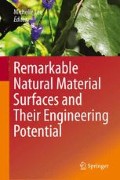Abstract
This chapter takes a look at the structural and surface properties of various types of spider silk that enable such remarkable performance as a fiber, as well as its past and potential uses in engineering. Though there are various types of spider webs such as tangle and sheet webs, the orb web is the most common and is spun and constructed by orb-weaving spiders, Araneus and Nephila. Orb-weaving spiders are capable of producing seven different types of silk threads, each with distinct combinations of amino acid composition, function, and gland and spinneret used in production (Saravanan, J Textile Apparel Technol Manag 5(1):1–20, 2006). Dragline silk, known to be the toughest of all types of silk, serves as the framework of the spider’s web, as well as its lifeline (Heim et al., Angew Chem Int Ed 48:3584–3596, 2009). Despite inevitable variations in the material properties of dragline silk across different species of spiders, it is still found to be tougher than most biological fibers and even man-made fibers (Swanson et al., Evolution 60(12):2539–2551, 2007). While spiders use dragline silk for web framework and as a lifeline, they also spin threads to capture their prey, which are called capture threads (Vollrath, Rev Mol Biotechnol 74(2):67–83, 2000). The adhesive properties of capture threads are made possible by an interlocking mechanism (Hawthorn, Biol J Linn Soc 77(1):1–8, 2002) and van der Waals and capillary forces (Sahni et al., J Adhes 87:595–614, 2011). Spider silk has numerous future engineering applications. New biopolymer materials to be used in the medical field are a possibility with the manipulation of spider silk proteins (Römer and Scheibel, Prion 2(4):154–161, 2008). Also, spider silk is being applied to a diverse array of applications within the military arena, including, but not limited to, being used as an underwater anchoring adhesive (Military Times, Navy bets on spider silk research with USU funding, http://www.militarytimes.com/article/20130807/NEWS04/308070038/Navy-bets-spider-silk-research-USU-funding, 2013).
Particular gratitude to Rose Gruenhagen for allowing me to consult her draft on spider silk.
Access this chapter
Tax calculation will be finalised at checkout
Purchases are for personal use only
References
Almelling C, Radtke C, Vogt PM (2013) Technical and biomedical uses of nature’s strongest fiber: spider silk. In: Nentwig W (ed) Spider ecophysiology. Springer, Berlin Heidelberg. doi:10.1007/978-3-642-33989-9_36
Bates D (2011) ‘Making science-fiction a reality’: bulletproof human skin made from spider silk and goat milk developed by researchers. http://www.dailymail.co.uk/sciencetech/article-2026645/Bulletproof-human-skin-spider-silk-goat-milk-developed-scientists.html. Accessed 8 Aug 2013
Bruns S, Stark Y, Marten D, Allmeling C, Kasper C, Stahl F, Scheper T (2010) A preliminary study on spider silk as biomaterial for peripheral nerve regeneration. ESACT Proceedings. Cells Culture 4:573–578. doi:10.1007/978-90-481-3419-9_99
Discovery (2012) Body armor made from spider silk. http://news.discovery.com/tech/gear-and-gadgets/body-armor-spider-silk-1210152.htm. Accessed 8 Aug 2013
Fredriksson C, Hedhammar M, Feinstein R, Nordling K, Kratz G, Johansson J, Huss F, Rising A (2009) Tissue response to subcutaneously implanted recombinant spider silk: an in vivo study. Materials 2:1908–1922. doi:10.3390/ma2041908
Gerritsen VB (2002) The tiptoe of an airbus. http://web.expasy.org/spotlight/back_issues/024/. Accessed 8 Aug 2013
Griggs J (2012) On the silk road. New Sci 213(2850):36–39
Harding E (2012) The gown of gold spun by a million spiders that revives a lost tradition. http://www.dailymail.co.uk/femail/article-2090608/Reviving-lost-tradition-Cape-silk-million-spiders-unveiled-new-exhibition.html. Accessed 1 Nov 2012
Hawthorn AC (2002) Evolution of adhesive mechanisms in cribellar spider prey capture thread: evidence for van der Waals and hygroscopic forces. Biol J Linn Soc 77(1):1–8. doi:10.1046/j.1095-8312.2002.00099.x
Heim M, Keerl D, Scheibel T (2009) Spider silk: from soluble protein to extraordinary fiber. Angew Chem Int Ed 48:3584–3596. doi:10.1002/anie.200803341
Lewis R (2001) Unraveling the weave of spider silk. http://www.mhhe.com/biosci/genbio/life/articles/article1.mhtml. Accessed 8 Aug 2013
McCook HC (1890) The strength of spiders and spider-webs. Popular Science Monthly 37:42
Military Times (2013) Navy bets on spider silk research with USU funding. http://www.militarytimes.com/article/20130807/NEWS04/308070038/Navy-bets-spider-silk-research-USU-funding. Accessed 8 Aug 2013
Mortazavi M, Nosonovsky M (2012) Polymer adhesion and biomimetic surfaces for green tribology. In: Nosonovsky M, Bhushan B (eds) Green tribology. Springer, Berlin Heidelberg, pp 173–219. doi:10.1007/978-3-642-23681-5_8
Opell BD (2001) Cribellum and calamistrum ontogeny in the spider family Uloboridae: linking functionally related but separate silk spinning features. J Arachnol 29(2):20–26
Opell BD, Schwend HS (2009) Adhesive efficiency of spider prey capture threads. Zoology 112(1):16–26. doi:10.1016/j.zool.2008.04.002
Purcell A (2012) The science of the golden spider-silk cape. http://www.newscientist.com/blogs/shortsharpscience/2012/01/the-science-of-the-spider-silk.html. Accessed 1 Nov 2012
Römer L, Scheibel T (2008) The elaborate structure of spider silk. Prion 2(4):154–161
Sahni V, Blackledge TA, Dhinojwala A (2011) A review on spider silk adhesion. J Adhes 87:595–614. doi:10.1080/00218464.2011.583588
Saravanan D (2006) Spider silk—structure, properties, and spinning. J Textile Apparel Technol Manag 5(1):1–20
Swanson BO, Blackledge TA, Beltran J, Hayashi CY (2006) Variation in the material properties of spider dragline silk across species. Appl Phys A 82(2):213–218. doi:10.1007/s00339-005-3427-6
Swanson BO, Blackledge TA, Summers AP, Hayashi CY (2007) Spider dragline silk: correlated and mosaic evolution in high-performance biological materials. Evolution 60(12):2539–2551. doi:10.1111/j.0014-3820.2006.tb01888.x
U.S. Army (1997) Untangling the web. http://www.ssc.army.mil/about/pao/pubs/warrior/97/nov/silk.htm. Accessed 8 Aug 2013
Vollrath F (2000) Strength and structure of spiders’ silks. Rev Mol Biotechnol 74(2):67–83. doi:10.1016/S1389-0352(00)00006-4
Vollrath F (2006) Spider silk: thousands of nano-filaments and dollops of sticky glue. Curr Biol 16(21):R925–R927. doi:10.1016/j.cub.2006.09.050
Wendt H, Hillmer A, Reimers K, Kuhbier JW, Schäfer-Nolte F, Allmeling C, Kasper C, Vogt PM (2011) Artificial skin—culturing of different skin cell lines for generating an artificial skin substitute on cross-weaved spider silk fibres. PLoS One 6(7):e21833. doi:10.1371/journal.pone.0021833
Author information
Authors and Affiliations
Corresponding author
Editor information
Editors and Affiliations
Rights and permissions
Copyright information
© 2014 Springer International Publishing Switzerland
About this chapter
Cite this chapter
Lee, M. (2014). Spider Silk: A Sticky Situation. In: Lee, M. (eds) Remarkable Natural Material Surfaces and Their Engineering Potential. Springer, Cham. https://doi.org/10.1007/978-3-319-03125-5_13
Download citation
DOI: https://doi.org/10.1007/978-3-319-03125-5_13
Published:
Publisher Name: Springer, Cham
Print ISBN: 978-3-319-03124-8
Online ISBN: 978-3-319-03125-5
eBook Packages: Chemistry and Materials ScienceChemistry and Material Science (R0)

